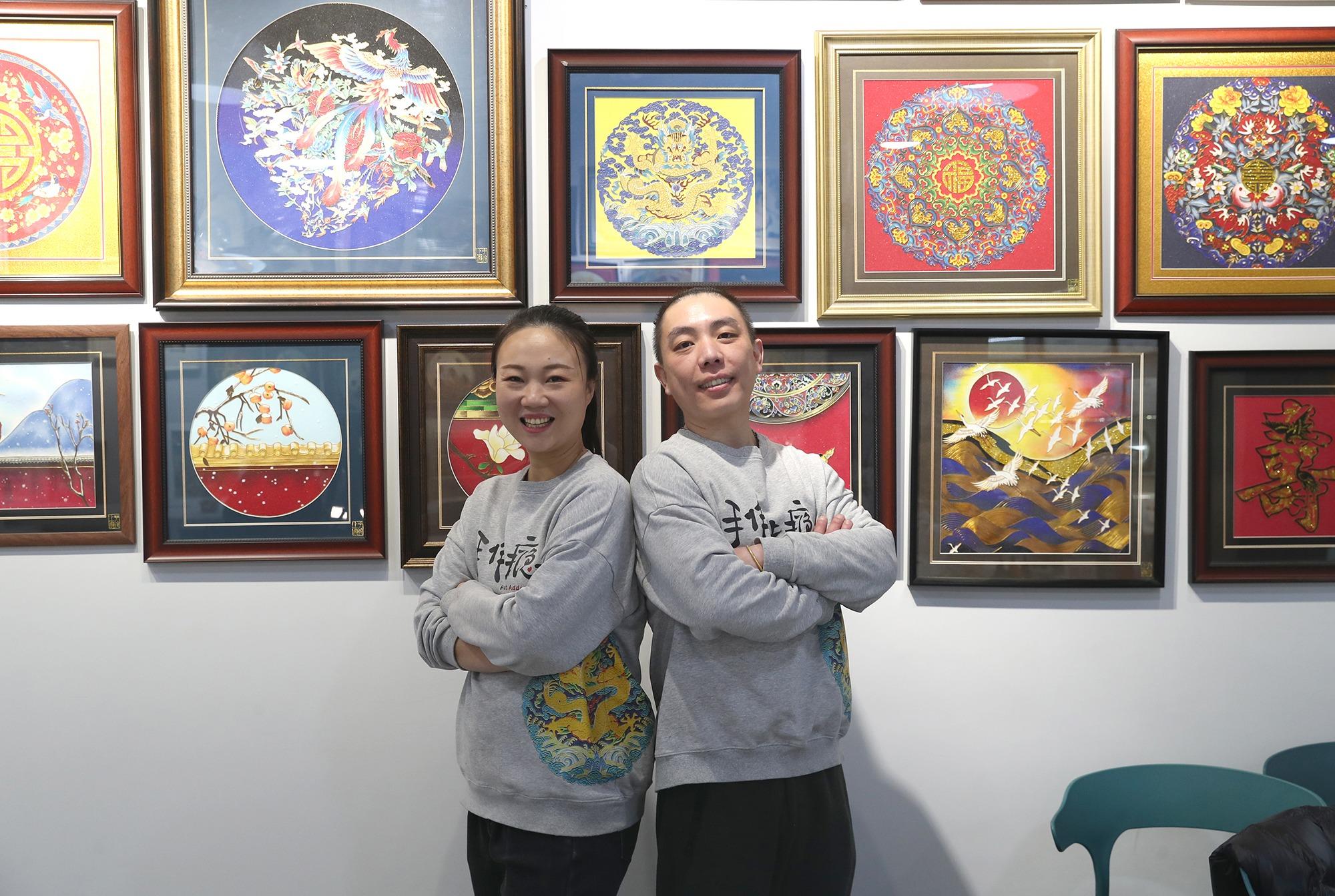 Guan Dian and her husband, Li Jinglong, run cloisonne workshops in Beijing. (ZOU HONG / CHINA DAILY)
Guan Dian and her husband, Li Jinglong, run cloisonne workshops in Beijing. (ZOU HONG / CHINA DAILY)
About eight years ago, Li Jinglong and Guan Dian visited the Palace Museum in Beijing. Like many tourists, the young couple were amazed by the ancient complex, which is also known as the Forbidden City. It was China's imperial palace from 1420 to 1911 and is home to over 1.86 million cultural relics. The cloisonne objects on display attracted them in particular.
"We spent hours looking at those beautiful objects. We just couldn't take our eyes off them," says Li.
We are happy to give people a glimpse of the traditional techniques of cloisonne as part of a DIY experience.
Guan Dian, cofounder of Handcraft Addicted workshops
Born and raised in Beijing, 35-year-old Li is no stranger to cloisonne, since there were a pair of cloisonne vases in his grandparents' home. His wife, 34-year-old Guan, who learned to paint as a child and later became a designer after graduating from the Beijing Institute of Fashion Technology, is also familiar with cloisonne, as it appears in her art books.
READ MORE: Tracing a golden legacy
As a result of their visit, the couple made the bold decision to open a workshop to promote Chinese-style cloisonne.
"We learned cloisonne after seeing the pieces displayed at the Palace Museum. We wanted to turn our hobby into a career, so that people could enjoy and learn to make the craft themselves," says Li, who worked in a finance company before quitting his job to launch Handcraft Addicted, a DIY workshop where participants can make cloisonne. Since 2018, they have opened three workshops in Beijing.
 Guan instructs a student on how to create a painting. (ZOU HONG / CHINA DAILY)
Guan instructs a student on how to create a painting. (ZOU HONG / CHINA DAILY)
Traditionally, the art of making cloisonne involves many steps, including making a metal base, soldering delicate metal strips bent to the outline of a design, filling the spaces with different colored pigments and firing. The couple simplify the process so that participants only have to learn to bend the thin metal wires into their desired pattern, and apply the powdered ore pigments.
Instead of focusing on making traditional cloisonne objects, such as plates and vases, the workshop allows participants to create the designs they want on panels of glass, resin or wood.
Although the process has been simplified, it is still not easy for people trying cloisonne for the first time to succeed.
Chang Yunqi has been making cloisonne art at Handcraft Addicted for about five years.
 The fish image involves soldering delicate metal strips bent to the outline of a design and filling the spaces with different colors. (ZOU HONG / CHINA DAILY)
The fish image involves soldering delicate metal strips bent to the outline of a design and filling the spaces with different colors. (ZOU HONG / CHINA DAILY)
When she and her classmates were looking for a place to celebrate their high school graduation in 2019, they checked online to look for somewhere fun. As none of them wanted to go to a restaurant or a karaoke bar, hoping to find something new to do, they chose to try Handcraft Addicted.
"I was curious about cloisonne, which is a very complicated, professional technique. I didn't know what to expect at the workshop until I saw different paintings made using the cloisonne technique," Chang says. She has since become one of the workshop's many fans.
Chang learned oil painting as a child and for her first try, chose to re-create The Birthday, a painting by French artist Marc Chagall.
"The thin metal wires resembled the pencil lines I draw on canvas. It was challenging but also interesting. The coloring process was magical. When I saw the finished result, which was based on an oil painting, presented in total different medium and approach, I was amazed," she says.
"Cloisonne is difficult, but this only involved two of the traditional steps. I can't imagine how hard it would be to make a full cloisonne piece."
 Cloisonne paintings created at Guan's workshops cover a wide range of themes, such as architecture and pandas. (ZOU HONG / CHINA DAILY)
Cloisonne paintings created at Guan's workshops cover a wide range of themes, such as architecture and pandas. (ZOU HONG / CHINA DAILY)
 Cloisonne paintings created at Guan's workshops cover a wide range of themes, such as architecture and pandas. (ZOU HONG / CHINA DAILY)
Cloisonne paintings created at Guan's workshops cover a wide range of themes, such as architecture and pandas. (ZOU HONG / CHINA DAILY)
 Cloisonne paintings created at Guan's workshops cover a wide range of themes, such as architecture and pandas. (ZOU HONG / CHINA DAILY)
Cloisonne paintings created at Guan's workshops cover a wide range of themes, such as architecture and pandas. (ZOU HONG / CHINA DAILY)
Since then, Chang has made one painting a year at the workshop, mostly her own interpretations of pieces by Western artists like Pablo Picasso and Salvador Dali.
One of her latest was based on John La Farge's Autumn Scattering Leaves, which she saw at the Metropolitan Museum of Art in New York in 2023. It took her seven months to finish.
"I have a full-time job, so I only go to the workshop in my spare time. Usually I spend three or four hours there concentrating on whatever I'm working on. It allows me to slow down and dedicate myself to the piece," she adds.
ALSO READ: Cultural capital
Guan says: "We are happy to give people a glimpse of the traditional techniques of cloisonne as part of a DIY experience. They spend months making one piece, which they take home or give friends as presents."
Li says it's a luxury for people to spend time alone and fully focus on one thing nowadays because of the fast pace of life. "We have many participants like Chang, who come to our workshop every week, not only to create art, but also to take a break from their busy lives."


